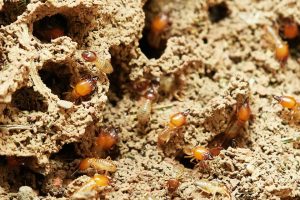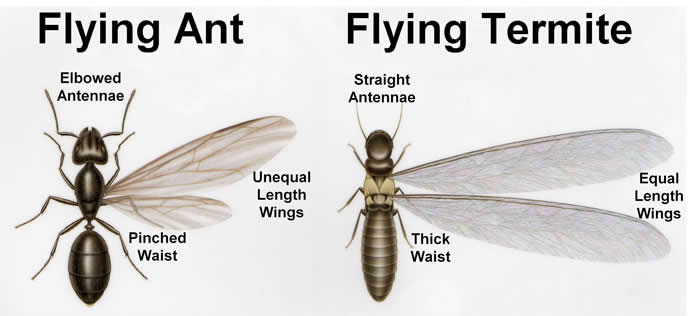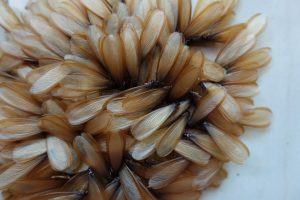Termite Pest Control Sydney
![]()
Need termite control?


Termites also known as white ants are small and a similar in size to ants. Due to their size and similarities to ants this can often lead to confusion. Knowing the differences between these two pests is a good starting point for identification.
Termites are secretive in nature which makes their detection difficult to an untrained eye. Most people would be more likely to spot the signs of termite damage rather than the actual termites.
Correct identification ensures the most effective treatment methods are used and allows you the home or business owner to choose appropriate prevention steps to try and avoid termite infestations in the future.
What Do Termites Look Like?
Do termites really look like ants?
Termite Pest Control Sydney
Termite alates or swarmers can look like flying ants. There is a simple way to determine if the flying ants you are seeing are termites or flying ants, and this is simply by how many body sections there are. As seen in the image below – Termite alates have 2 body sections while standard flying ants have 3.

Here’s how to establish the general differences in appearance and behaviour between ants and termites:
- Termites have a straight waist, ants have a pinched waist.
- Straight antennae, ants have bent antennae.
- Their wings are the same length, ants have wings of different length.
NOTE: Flying ants do not shed their wings. If you have seen flying ants in your property and have found discarded wings,chances are you have identified termites in your property.

Termite Pest Control Sydney – How can termite damage be identified?
Rather than just looking at the areas where visible damage has been identified, Pest Control Today confirms termite infestations with a visual inspection and the use of a termatrac system.
When checking your property whether it be your residential home or business there are some points that could assist you in identifying possible termite activity.
Subterranean termites begin their feeding process from the ground up and enter a building through the sub-structure. Houses that are built on concrete slabs can still be affected if the slab has cracked and allowed an opening from the soil through the slab to the house.
Houses that have an open access sun floor or crawl space are at a great risk of termite infestations. This area should be checked for evidence of wood damage and/or mud tubes.
This species of termite damages the wood by developing hollow tunnels known as galleries which run along the wood grain.
Drywood termites usually enter the building near the roof line or in areas where wood has been exposed. Attics and roof cavities should be checked for wood that has been damaged. You may see tiny holes in the wood with collected frass nearby. Probing the wood can also expose galleries
I have found termites, what do I do?
Finding termites in your home can be distressing, however Pest Control Today recommends firstly that you stay calm and call a professional. Do not disturb any termite workings, mud trails, leads of galleries and we ask that you do not spray the area with any insecticides as it can be make treatment harder.
How are termites treated?
Not all building structures are the same Pest Control Today will offer you a program designed to suit your properties needs.
There are 2 ways to treat termites, baiting/dusting or direct chemical treatment. Sometimes a combination of both treatments will be required or recommend.
Baiting or Dusting
Termite baiting
is conducted by placing bait stations in specific areas around your home which are baited using a non-chemical bait that contains an active ingredient which the termites eat and carry back to the colony where they share it amongst other termites in the nest.
Termite Dusting
is completed using Termidor Dust which is a non-repellent which is very similar to the material used in the bait systems. Small holes are made into the infested timber or directly on termite trails. The fine dust is applied directly to the termites and the holes are then covered which prevents any dust escaping and to also reduce the risk of the termites being disturbed.
NOTE: Termite dusting & baiting does not provide protection to the building from future termite infestations.
Chemical Application
Termite Soil Treatment
Preferred option by many pest controllers however its use does depend on the construction type of your property. The treatment is applied to soil areas where the building is in contact with:
- Subfloor
- Concrete slab perimeters
- External wall perimeters.
If there is a distance greater than 400mm between the soil and the timbers in the floor, the subfloor would also be trenched and treated, however it is preferred that the entire sub floor area is treated which increases the coverage area in the subfloor which in then increases the chance of the termites encountering the chemical.
Drilling & Injection of chemical to the concrete perimeters occur approximately at 20-30cm intervals. The drilled holes are then re concreted on completion
The areas that may need to be drilled and injected can include:
- Patios
- Paths
- Garage
- Fireplaces
- Bathrooms
- Laundries
- External Perimeter Walls
What types of soil treatments are there for termites?
There are 2 main types of soil treatment available, the repellent and the non-repellent.
Repellent
This type of termiticide works by creating a barrier around the house which create a no-go zone for termites. For this treatment to be effective it needs to be applied in an unbroken method around the foundations. This method is often difficult to achieve simply because of the construction and design of your property or if there Is concrete against the house.
Non-repellent
This type of termiticide works as termites are unable to detect the area that has been treated and will not avoid the treated area. When termites pass through the chemical in the treated area they become in contact with it, return to the nest and pass it amongst the other termites in the colony.
Pest Control Today Recommendations

- Disturb any termite workings, leads, galleries.
- Spray termite infested area with any chemical.
- Plant trees or plants close to the house.
- Add mulch or any type of bark to the gardens too close to the property.
- Cover weep holes in brickwork.
- Allow soil to build up over the edge of the slabs.
- Place plastic or newspaper on gardens.
- Allow moisture or dampness to build up in the sub floor as poor sub-floor drainage will attract termites.
If you notice or worried about possible termite activity do not hesitate to seek professional assistance.
You should check the following areas on a regular basis
- Timber frames inside the home
- Fences
- Blistered paint on the walls
- Bulging or rippled walls
- Timber joints or gyp-rock walls for mud packing
- Foundation walls, piers and edges of concrete slabs for termite mud galleries
- Form-work timbers beneath suspended concrete patios
Remove any:
- Stored timber or cardboard that is contact with the ground in the sub-floor
- Timber stored alongside the house & kept as far away from the house as possible
Common misconceptions about termites
Myth: Termite damage can be easily seen
Fact: As termites eat wood from the inside out a new termite infestation would not have any visual signs that can be easily seen. By the time damage is noticed on the outside of the wood, extensive damage could have already occurred.
Myth: Termites are more active during spring and summer
Fact: Termites are active all year round.
Myth: Preventing termites is hard
Fact: Termite prevention is a matter of common sense and regular home maintenance such as
- Keeping gutters clean of debris
- Removing dead trees and their stumps
- Removing fallen branches
- Keeping timber and firewood off the ground and away from your home.
- Fixing water leaks in and around your home
- Having your home inspected annually by a timber pest expert. Click here to read more about termite inspections.
Pest Control Today highly recommends annual Termite Inspections.

![]() Each property, building and location is different, a customised management solution should be designed to suit your specific needs.
Each property, building and location is different, a customised management solution should be designed to suit your specific needs.
We would love to find out more on how we may be able to help you.
Click to call or contact with us via the contact form available at our website.

